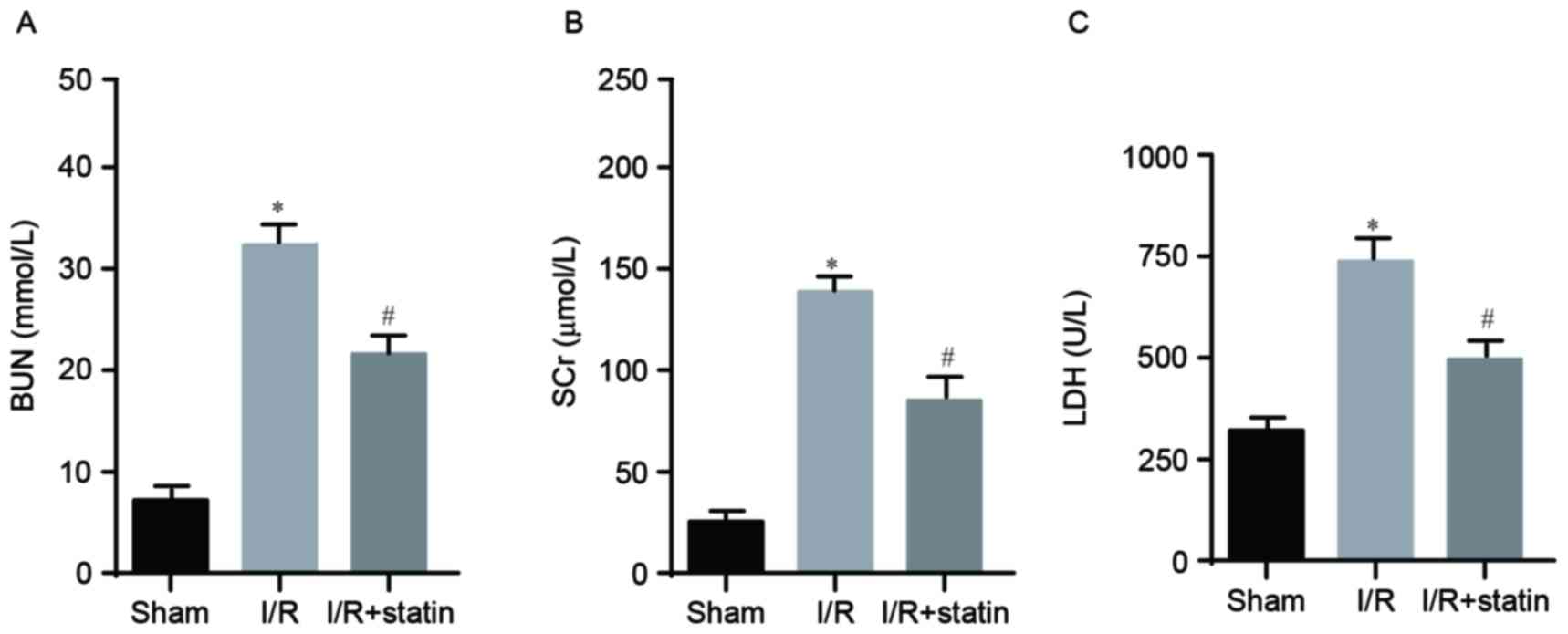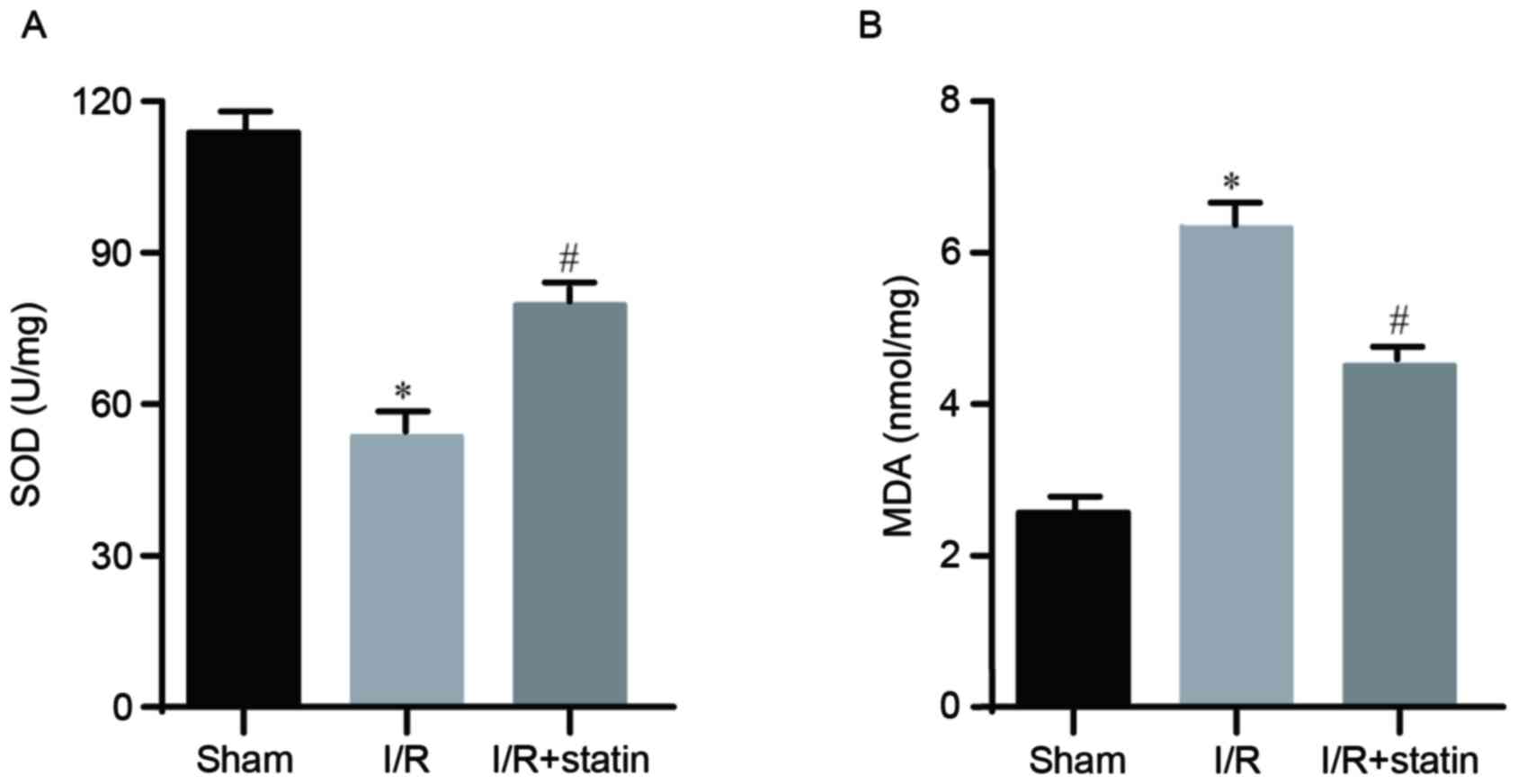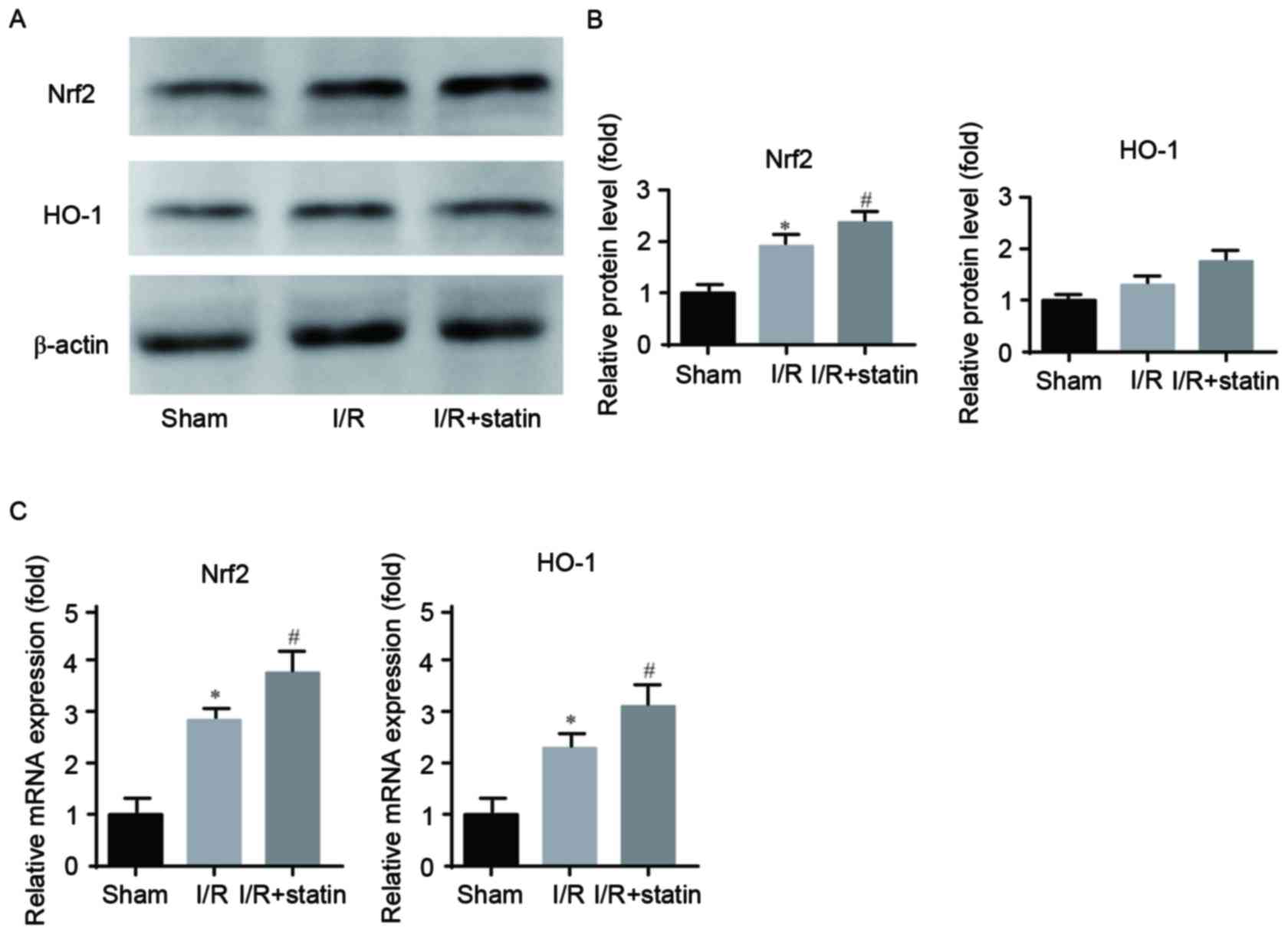|
1
|
Anaya-Prado R, Toledo-Pereyra LH, Lentsch
AB and Ward PA: Ischemia/reperfusion injury. J Surg Res.
105:248–258. 2002. View Article : Google Scholar : PubMed/NCBI
|
|
2
|
Nath KA and Norby SM: Reactive oxygen
species and acute renal failure. Am J Med. 109:665–678. 2000.
View Article : Google Scholar : PubMed/NCBI
|
|
3
|
Tsuda H, Kawada N, Kaimori JY, Kitamura H,
Moriyama T, Rakugi H, Takahara S and Isaka Y: Febuxostat suppressed
renal ischemia-reperfusion injury via reduced oxidative stress.
Biochem Biophys Res Commun. 427:266–272. 2012. View Article : Google Scholar : PubMed/NCBI
|
|
4
|
Feng L, Ke N, Cheng F, Guo Y, Li S, Li Q
and Li Y: The protective mechanism of ligustrazine against renal
ischemia/reperfusion injury. J Surg Res. 166:298–305. 2011.
View Article : Google Scholar : PubMed/NCBI
|
|
5
|
Shokeir AA, Barakat N, Hussein AM,
Awadalla A, Harraz AM, Khater S, Hemmaid K and Kamal AI: Activation
of Nrf2 by ischemic preconditioning and sulforaphane in renal
ischemia/reperfusion injury: A comparative experimental study.
Physiol Res. 64:313–323. 2015.PubMed/NCBI
|
|
6
|
Jiang G, Liu X, Wang M, Chen H, Chen Z and
Qiu T: Oxymatrine ameliorates renal ischemia-reperfusion injury
from oxidative stress through Nrf2/HO-1 pathway. Acta Cir Bras.
30:422–429. 2015. View Article : Google Scholar : PubMed/NCBI
|
|
7
|
Lin L, Zheng J, Zhu W and Jia N:
Nephroprotective effect of gelsemine against cisplatin-induced
toxicity is mediated via attenuation of oxidative stress. Cell
Biochem Biophys. 71:535–541. 2015. View Article : Google Scholar : PubMed/NCBI
|
|
8
|
Jaiswal AK: Nrf2 signaling in coordinated
activation of antioxidant gene expression. Free Radic Biol Med.
36:1199–1207. 2004. View Article : Google Scholar : PubMed/NCBI
|
|
9
|
Zhang L, Zhu Z, Liu J, Zhu Z and Hu Z:
Protective effect of N-acetylcysteine (NAC) on renal
ischemia/reperfusion injury through Nrf2 signaling pathway. J
Recept Signal Transduct Res. 34:396–400. 2014. View Article : Google Scholar : PubMed/NCBI
|
|
10
|
Goldstein JL and Brown MS: Regulation of
the mevalonate pathway. Nature. 343:425–430. 1990. View Article : Google Scholar : PubMed/NCBI
|
|
11
|
Gueler F, Rong S, Park JK, Fiebeler A,
Menne J, Elger M, Mueller DN, Hampich F, Dechend R and Kunter U:
Postischemic acute renal failure is reduced by short-term statin
treatment in a rat model. J Am Soc Nephrol. 13:2288–2298. 2002.
View Article : Google Scholar : PubMed/NCBI
|
|
12
|
Wu K, Lei W, Tian J and Li H: Atorvastatin
treatment attenuates renal injury in an experimental model of
ischemia-reperfusion in rats. BMC Nephrol. 15:142014. View Article : Google Scholar : PubMed/NCBI
|
|
13
|
Haylor JL, Harris KP, Nicholson ML, Waller
HL, Huang Q and Yang B: Atorvastatin improving renal ischemia
reperfusion injury via direct inhibition of active caspase-3 in
rats. Exp Biol Med (Maywood). 236:755–763. 2011. View Article : Google Scholar : PubMed/NCBI
|
|
14
|
Randomized trial of cholesterol lowering
in 4444 patients with coronary heart disease: The scandinavian
simvastatin survival study (4S). Lancet. 344:1383–1389.
1994.PubMed/NCBI
|
|
15
|
Levine GN, Keaney JF Jr and Vita JA:
Cholesterol reduction in cardiovascular disease. Clinical benefits
and possible mechanisms. N Engl J Med. 332:512–521. 1995.
View Article : Google Scholar : PubMed/NCBI
|
|
16
|
Endres M, Laufs U, Huang Z, Nakamura T,
Huang P, Moskowitz MA and Liao JK: Stroke protection by
3-hydroxy-3-methylglutaryl (HMG)-CoA reductase inhibitors mediated
by endothelial nitric oxide synthase. Proc Natl Acad Sci U S A.
95:8880–8885. 1998. View Article : Google Scholar : PubMed/NCBI
|
|
17
|
Pruefer D, Scalia R and Lefer AM:
Simvastatin inhibits leukocyte-endothelial cell interactions and
protects against inflammatory processes in normocholesterolemic
rats. Arterioscler Thromb Vasc Biol. 19:2894–2900. 1999. View Article : Google Scholar : PubMed/NCBI
|
|
18
|
Lefer AM, Campbell B, Shin YK, Scalia R,
Hayward R and Lefer DJ: Simvastatin preserves the
ischemic-reperfused myocardium in normocholesterolemic rat hearts.
Circulation. 100:178–184. 1999. View Article : Google Scholar : PubMed/NCBI
|
|
19
|
McCord JM: The evolution of free radicals
and oxidative stress. Am J Med. 108:652–659. 2000. View Article : Google Scholar : PubMed/NCBI
|
|
20
|
Livak KJ and Schmittgen TD: Analysis of
relative gene expression data using real-time quantitative PCR and
the 2(-Delta Delta C(T)) Method. Methods. 25:402–408. 2001.
View Article : Google Scholar : PubMed/NCBI
|
|
21
|
Tuuminen R, Nykänen AI, Saharinen P,
Gautam P, Keränen MA, Arnaudova R, Rouvinen E, Helin H, Tammi R and
Rilla K: Donor simvastatin treatment prevents ischemia-reperfusion
and acute kidney injury by preserving microvascular barrier
function. Am J Transplant. 13:2019–2034. 2013. View Article : Google Scholar : PubMed/NCBI
|
|
22
|
Todorovic Z, Nesic Z, Stojanović R,
Basta-Jovanović G, Radojevic-Skodrić S, Velicković R, Chatterjee
PK, Thiemermann C and Prostran M: Acute protective effects of
simvastatin in the rat model of renal ischemia-reperfusion injury:
It is never too late for the pretreatment. J Pharmacol Sci.
107:465–470. 2008. View Article : Google Scholar : PubMed/NCBI
|
|
23
|
McCord JM: Oxygen-derived free radicals in
postischemic tissue injury. N Engl J Med. 312:159–163. 1985.
View Article : Google Scholar : PubMed/NCBI
|
|
24
|
Halliwell B and Gutteridge J.M.C: Free
radicals, other reactive species and diseaseFree Radicals in
Biology and Medicine. Third. Oxford University Press; Oxford: pp.
617–783. 1999
|
|
25
|
Guidet BR and Sudh SV: In vivo generation
of hydrogen peroxide by rat kidney cortex and glomeruli. Am J
Physiol. 256:F158–F164. 1989.PubMed/NCBI
|
|
26
|
Andreucci VE and Fine LG: Reactive oxygen
species and renal injuryInternational Yearbook of Nephrology. 1st.
Kluwer Academic Press; New York, NY: pp. 47–69. 1991
|
|
27
|
Szeto HH: Mitochondria-targeted
cytoprotective peptides for ischemia-reperfusion injury. Antioxid
Redox Signal. 10:601–619. 2008. View Article : Google Scholar : PubMed/NCBI
|
|
28
|
Tartibian B and Maleki BH: The effects of
honey supplementation on seminal plasma cytokines, oxidative stress
biomarkers and antioxidants during 8 weeks of intensive cycling
training. J Androl. 33:449–461. 2012. View Article : Google Scholar : PubMed/NCBI
|
|
29
|
Daemen MA, van de Ven MW, Heineman E and
Buurman WA: Involvement of endogenous interleukin-10 and tumor
necrosis factor-alpha in renal ischemia-reperfusion injury.
Transplantation. 67:792–800. 1999. View Article : Google Scholar : PubMed/NCBI
|
|
30
|
Daemen MA, van 't Veer C, Denecker G,
Heemskerk VH, Wolfs TG, Clauss M, Vandenabeele P and Buurman WA:
Inhibition of apoptosis induced by ischemia-reperfusion prevents
inflammation. J Clin Invest. 104:541–549. 1999. View Article : Google Scholar : PubMed/NCBI
|
|
31
|
Kim HJ and Vaziri ND: Contribution of
impaired Nrf2-Keap1 pathway to oxidative stress and inflammation in
chronic renal failure. Am J Physiol Renal Physiol. 298:F662–671.
2010. View Article : Google Scholar : PubMed/NCBI
|
|
32
|
Kobayashi M and Yamamoto M: Molecular
mechanisms activating the Nrf2-Keap1 pathway of antioxidant gene
regulation. Antioxid Redox Signal. 7:385–394. 2005. View Article : Google Scholar : PubMed/NCBI
|
|
33
|
Chartoumpekis D, Ziros PG, Psyrogiannis A,
Kyriazopoulou V, Papavassiliou AG and Habeos IG: Simvastatin lowers
reactive oxygen species level by Nrf2 activation via PI3K/Akt
pathway. Biochem Biophys Res Commun. 396:463–466. 2010. View Article : Google Scholar : PubMed/NCBI
|
|
34
|
Jang HJ, Hong EM, Kim M, Kim JH, Jang J,
Park SW, Byun HW, Koh DH, Choi MH, Kae SH and Lee J: Simvastatin
induces heme oxygenase-1 via NF-E2-related factor 2 (Nrf2)
activation through ERK and PI3K/Akt pathway in colon cancer.
Oncotarget. 7:46219–46229. 2016. View Article : Google Scholar : PubMed/NCBI
|
|
35
|
Habeos IG, Ziros PG, Chartoumpekis D,
Psyrogiannis A, Kyriazopoulou V and Papavassiliou AG: Simvastatin
activates Keap1/Nrf2 signaling in rat liver. J Mol Med (Berl).
86:1279–1285. 2008. View Article : Google Scholar : PubMed/NCBI
|



















